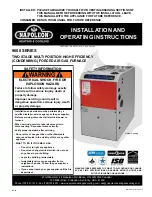
21
NOTE
: In determining the free area of an opening, the blocking
effect of the louvers, grilles, and screens must be considered. If
the free area of a louver or grille design is unknown, it may be
assumed that wood louvers have a 20 percent free area, and metal
louvers or grilles have a 60 percent free area. Screens, when used,
must not be smaller than 1/4-in. (6 mm) mesh. Louvers and
grilles must be constructed so they cannot be closed.
When combustion air ducts are used, they must be of the same
cross sectional area as the free area of the openings to which they
connect. The minimum dimension of ducts must not be less than
3 in. (76 mm).
Combination of Indoor and Outdoor Air
1. Indoor openings shall comply with the
Indoor
Combustion Air
Method below and,
2. Outdoor openings shall be located as required in
the
Outdoor Combustion Air
Method mentioned
previously and,
3. Outdoor openings shall be sized as follows:
a. Calculate the Ratio of all Indoor Space volume divided
by required volume for
Indoor Combustion Air
Method below.
b. Outdoor opening size reduction
Factor
is 1 minus the
Ratio
in a. above.
c. Minimum size of Outdoor openings shall be the size
required in
Outdoor Combustion Air
Method above
multiplied by reduction
Factor
in b. above. The
minimum dimension of air openings shall be not less
than 3 in. (76 mm).
INSTALLATION
Step 1 -- Leveling Legs (If Desired)
When furnace is used in upflow position with side inlet(s),
leveling legs may be desired. (See Fig. 20.) Install field-supplied,
corrosion-resistant 5/16-in. machine bolts and nuts.
NOTE
: The maximum length of bolt should not exceed 1-1/2 in.
(38 mm).
1. Position furnace on its back. Locate and drill a 5/16-in. (8
mm) diameter hole in each bottom corner of furnace. (See
Fig. 20.) Holes in bottom closure panel may be used as
guide locations.
2. For each hole, install nut on bolt and then install bolt and
nut in hole. (Install flat washer if desired.)
3. Install another nut on other side of furnace base. (Install
flat washer if desired.)
4. Adjust outside nut to provide desired height, and tighten
inside Nut to secure arrangement.
NOTE
: Bottom closure must be used when leveling legs are
used. See Bottom Closure Panel section.
Step 2 -- Installation in Upflow and Downflow
Applications
NOTE
: For downflow applications, this furnace is approved for
use on combustible flooring when special base (available from
manufacturer) Part No. KGASB0201ALL is used. Special base is
not required when this furnace is installed on manufacturer’s Coil
Assembly Part No. CAP, CAR or CNPV, CNRV, or Coil Box Part
No. KCAKC is used.
1
3
/
4
″
1
3
/
4
″
1
3/
4
″
1
3/
4
″
5/
16
″
5
/
16
″
5/
16
″
5/
16
″
(44mm)
(8mm)
(44mm)
(8mm)
(8mm)
(8mm)
(44mm)
(44mm)
A89014
Fig. 20 -- Leveling Legs
1. Determine application being installed from Table 3.
2. Construct hole in floor per dimensions specified in Table 3
and Fig. 21.
3. Construct plenum to dimensions specified in Table 3
and Fig. 21.
4. If downflow subbase (KGASB) is used, install as shown in
Fig. 22. If Coil Assembly Part No. CAP, CAR or CNPV,
CNRV or Coil Box Part No. KCAKC is used, install as
shown in Fig. 23.
NOTE
:
Remove furnace perforated, supply-air duct flanges
when they interfere with mating flanges on coil or downflow
subbase. To remove perforated, supply-air duct flanges, use wide
duct pliers, duct flange tool, or hand seamers to bend flange back
and forth until it breaks off. Be careful of sharp edges.
(See Fig. 24.)
UNIT MAY NOT OPERATE
Failure to follow this caution may result in intermittent unit
operation.
Do not bend duct flanges inward as shown in Fig. 21. This
will affect airflow across heat exchangers and may cause limit
cycling or premature heat exchanger failure. Remove duct
flange completely or bend it inward a minimum of 210
°
as
shown in Fig. 24.
CAUTION
!
Step 3 -- Installation in Horizontal Applications
These furnaces can be installed horizontally in either horizontal left
or right discharge position. In a crawlspace, the furnace can either
be hung from floor joist or installed on suitable blocks or pad.
Furnace can be suspended from each corner by hanger bolts and
angle iron supports. (See Fig. 25.) Cut hanger bolts (4 each 3/8-in.
all-thread rod) to desired length. Use 1 X 3/8-in. flat washers,
3/8-in. lock washers, and 3/8-in. nuts on hanger rods as shown in
Fig. 25. Dimples are provided for hole locations. (See Fig. 2.)














































